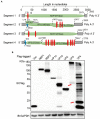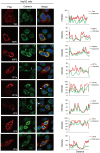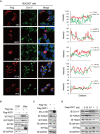Characterization and subcellular localization of Alongshan virus proteins
- PMID: 36238596
- PMCID: PMC9551281
- DOI: 10.3389/fmicb.2022.1000322
Characterization and subcellular localization of Alongshan virus proteins
Abstract
Alongshan virus (ALSV) in the Jingmenvirus group within the family Flaviviridae is a newly discovered tick-borne virus associated with human disease, whose genome includes four segments and encodes four structural proteins (VP1a, VP1b, VP2, VP3, and VP4) and two non-structural proteins (NSP1 and NSP2). Here, we characterized the subcellular distribution and potential function of ALSV proteins in host cells. We found that viral proteins exhibited diverse subcellular distribution in multiple tissue-deriving cells and induced various morphological changes in the endoplasmic reticulum (ER), and NSP2, VP1b, VP2, and VP4 were all co-localized in the ER. The nuclear transfer and co-localization of VP4 and calnexin (a marker protein of ER), which were independent of their interaction, were unique to HepG2 cells. Expression of NSP1 could significantly reduce mitochondria quantity by inducing mitophagy. These findings would contribute to better understanding of the pathogenesis of emerging segmented flaviviruses.
Keywords: Alongshan virus; characterization; segmented flavivirus; subcellular localization; viral proteins.
Copyright © 2022 Zhao, Wu, Liu, Ma, Pan, Huang, Du, Yu, Sui, Wang, Hou and Liu.
Conflict of interest statement
The authors declare that the research was conducted in the absence of any commercial or financial relationships that could be construed as a potential conflict of interest.
Figures






Similar articles
-
Epidemiology and global spread of emerging tick-borne Alongshan virus.Emerg Microbes Infect. 2024 Dec;13(1):2404271. doi: 10.1080/22221751.2024.2404271. Epub 2024 Sep 24. Emerg Microbes Infect. 2024. PMID: 39259276 Free PMC article. Review.
-
Crystal structure of the NS3-like helicase from Alongshan virus.IUCrJ. 2020 Apr 10;7(Pt 3):375-382. doi: 10.1107/S2052252520003632. eCollection 2020 May 1. IUCrJ. 2020. PMID: 32431821 Free PMC article.
-
Quantitative Polymerase Chain Reaction System for Alongshan Virus Detection.Methods Protoc. 2023 Sep 4;6(5):79. doi: 10.3390/mps6050079. Methods Protoc. 2023. PMID: 37736962 Free PMC article.
-
Prevalence of the emerging novel Alongshan virus infection in sheep and cattle in Inner Mongolia, northeastern China.Parasit Vectors. 2019 Sep 12;12(1):450. doi: 10.1186/s13071-019-3707-1. Parasit Vectors. 2019. PMID: 31511049 Free PMC article.
-
The discovery of segmented flaviviruses: implications for viral emergence.Curr Opin Virol. 2020 Feb;40:11-18. doi: 10.1016/j.coviro.2020.02.001. Epub 2020 Mar 24. Curr Opin Virol. 2020. PMID: 32217446 Review.
Cited by
-
Development of a loop-mediated isothermal amplification assay for the rapid detection of Alongshan virus.J Gen Virol. 2025 May;106(5):002094. doi: 10.1099/jgv.0.002094. J Gen Virol. 2025. PMID: 40338960 Free PMC article.
-
The segmented flavivirus Alongshan virus reduces mitochondrial mass by degrading STAT2 to suppress the innate immune response.J Virol. 2025 Jan 31;99(1):e0130124. doi: 10.1128/jvi.01301-24. Epub 2024 Dec 10. J Virol. 2025. PMID: 39655955 Free PMC article.
-
Epidemiology and global spread of emerging tick-borne Alongshan virus.Emerg Microbes Infect. 2024 Dec;13(1):2404271. doi: 10.1080/22221751.2024.2404271. Epub 2024 Sep 24. Emerg Microbes Infect. 2024. PMID: 39259276 Free PMC article. Review.
-
Alongshan virus: An emerging arboviral challenge in regional health security.Virulence. 2025 Dec;16(1):2492360. doi: 10.1080/21505594.2025.2492360. Epub 2025 Apr 15. Virulence. 2025. PMID: 40233926 Free PMC article. Review.
-
Strange relatives: the enigmatic arbo-jingmenviruses and orthoflaviviruses.Npj Viruses. 2025 Apr 4;3(1):24. doi: 10.1038/s44298-025-00106-z. Npj Viruses. 2025. PMID: 40295693 Free PMC article. Review.
References
-
- Agarwal A., Alam M. F., Basu B., Pattanayak S., Asthana S., Syed G. H., et al. (2022). Japanese encephalitis virus NS4A protein interacts with PTEN-induced kinase 1 (PINK1) and promotes mitophagy in infected cells. Microbiol. Spectr. 10:e0083022. doi: 10.1128/spectrum.00830-22, PMID: - DOI - PMC - PubMed
LinkOut - more resources
Full Text Sources

